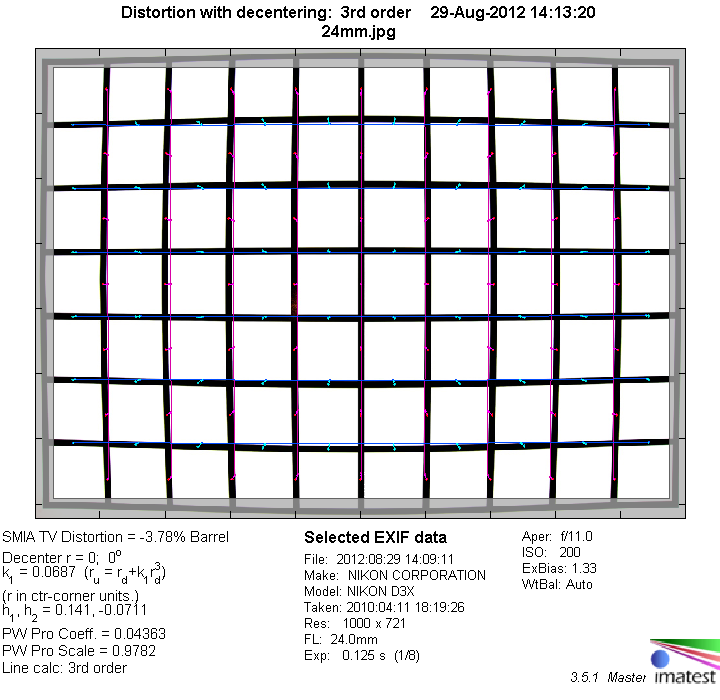|
Page 2 of 3

Distortion
Typical for most standard zooms reaching down to 24mm, the Nikkor shows a large amount of barrel distortion at its shortest focal length. At 35mm, the lens produces images that are free of distortion. Zomming in further, the type of distortion switches to the pincushion kind. At normal focal length and even more so in the tele range, pincushion distortion is rather pronounced.
|
Move the mouse cursor over the focal length text marks below to observe the respective distortion
|
| 24mm |
35mm |
50mm |
85mm |
|

|
The chart above has a real-world size of about 120x80cm.
The image below gives an impression of the impact of high distortion on real world subjects.

Vignetting
The lens shows a very high amount of vignetting at its shortest focal length wide open. Stopped down the light fall-off comes down to lower levels, but with an amount of 1 stop/EV left at f/11 vignetting can still be a visible issue with many subjects.
At longer focal lengths, vignetting is somewhat pronounced wide open (especially at 85mm), but stopping down just one stop helps to solve the issue, except for critical scenes.
We're performing our vignetting analysis based on
(uncorrected) JPEGs straight from the camera. The JPG engine of the Nikon D3x features a rather flat
gradation curve, thus has a moderate contrast characteristic, resulting in comparatively low vignetting figures - the
corresponding Canon figures are roughly 40% higher due to the more
aggressive default contrast setting.

MTF (resolution)
Let's start with the good news: when stopped down slightly, the lens delivers excellent resolution in the image center at all tested focal lengths. Wide open, the resolution is very good, except at 85mm, where the resolution drops a bit more at the largest aperture (f/4).
The borders and corners are a very different story, though. Wide open, they are downright poor for any tested focal length except 50mm (where they are only marginally better). The lens needs to be stopped down to f/5.6 or even f/8 to get good performance across the whole frame.
Please note that the MTF results are not directly comparable across the different systems!
Below is a simplified summary of the formal findings. The chart shows line widths
per picture height (LW/PH) which can be taken as a measure for sharpness.
If you want to know more about the MTF50 figures you may check out the corresponding
Imatest Explanations

Chromatic Aberrations (CAs)
Chromatic aberrations (color shadows at harsh contrast transitions) are only moderate, especially at large aperture settings. At medium focal lengths (35 and 50mm) they increase to more pronounced levels by stopping down.
However, CAs can easily be corrected in software or by the camera itself (most modern Nikon DSLRs remove CAs themselves if you shoot JPGs).

Bokeh
With an aperture of f/4 at the tele end of the zoom range, the Nikkor can not really be called a fast lens. However, it features the classic focal length for portraiture (85 mm) and on a full frame camera, on can still separate the subject from the background at this focal length and aperture, even though it may require a bit more space between subject and background than with faster lenses. That's why we had a quick look at the bokeh quality of the lens at its longest zoom setting.
The image blur is very smooth in front of the focal plane, but that's not something you'll be able to make use of in the field very often.
The more important background blur is less impressive. The bokeh looks a bit nervous here.
Thanks to 9 rounded aperture blades, background highlights remain circular even when the lens is stopped down. Unfortunately they show a fair amount of outlining.

|